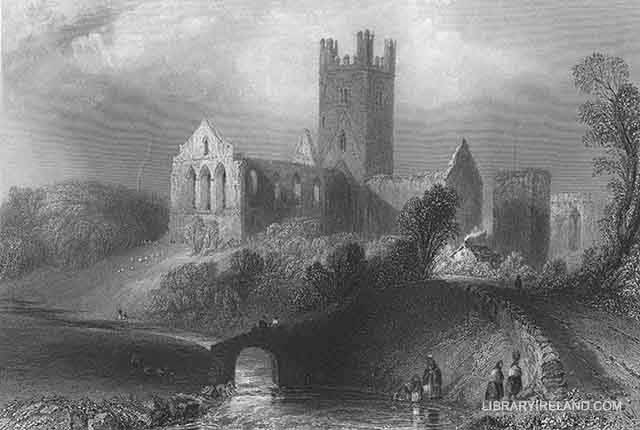Jerpoint Abbey, Kilkenny
On the same river, "the stubborn Nore," as Spenser calls it, stands JERPOINT ABBEY, founded by Donogh M'Gilla-Patrick, Prince of Ossory. In wealth, honours, and architectural splendours, Jerpoint was exceeded by no other monastic institution in Ireland. The demesne lands extended over fifteen hundred acres of fertile ground, and the buildings included the abbey-church and tower, a refectory, dormitory, and offices, that occupied an area of three acres. The whole of this property, bequeathed for objects purely sacred, was granted at the dissolution to Thomas Butler, tenth Earl of Ormonde, at an annual rent of £49 3s. 9d.
"The style of architecture combines the Anglo-Norman and early English; and those parts that survive, and are approachable, display a beauty and perfection not inferior to anything of coeval structure in the kingdom; but from neglect and barbarity, this most splendid ruin is so injured and polluted, that the proportions of its vast choir and wide-spread arches, the shattered frames of the richly traced windows, with the mouldering fragments of sepulchral monuments, scattered over a surface of mire and filth, prohibit ingress or inspection. Exterior vestiges still appear of those buildings within whose shade the monks, on days of high solemnity, passed in their customary processions; but now they lie in masses of detached ruin, covered over with earth and grass, and distinguishable only by the eminence they form.
"The tomb of the founder is placed opposite the high altar in the south aisle, and adorned with the recumbent effigies of a male and female in antique costumes. The male is represented holding a crucifix in his right hand, which rests upon his breast, while the left points to a harp hanging at his side. A full-length figure of an abbot, in his proper robes, reclines upon the marble torus of another tomb: in his left hand appears a crozier, in the volute of which an Agnus Dei is sculptured. Other monuments of exquisite workmanship present a melancholy disregard of proper feeling, and a wanton profaneness, by their shattered fronts and spoliated appearance; and the inscriptions of all are nearly effaced.
"The monument of Dullany lies obscured in the ruinous confusion and heaps of decay. He died in the year 1202, was interred on the north side of the high-altar, and many miracles are said to have been wrought at his tomb.
END OF CHAPTER XIII.

